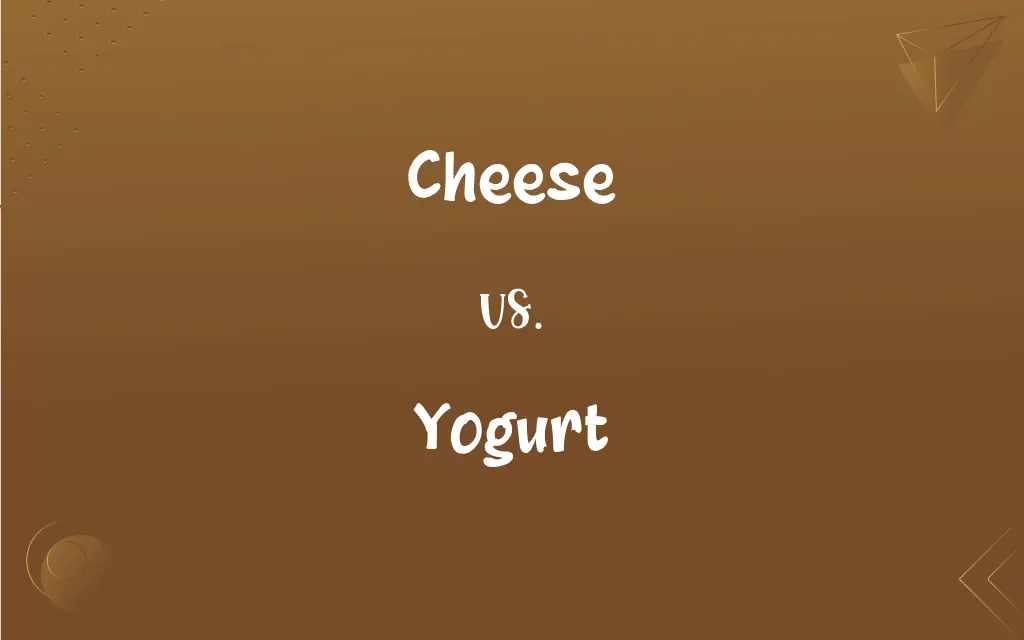Cheese vs. Yogurt: What's the Difference?
Edited by Aimie Carlson || By Janet White || Published on January 14, 2024
Cheese is a dairy product made by coagulating milk proteins, while yogurt is a dairy product created by fermenting milk with specific bacteria.

Key Differences
Cheese is created through the process of coagulating milk, leading to the separation of curds and whey. Yogurt, on the other hand, is produced by fermenting milk with specific bacterial cultures, which gives it a distinct tangy taste.
Cheese comes in numerous varieties, from hard and aged to soft and fresh, each with unique flavors and textures. Yogurt is typically smooth and creamy, but can vary in thickness and tartness depending on the fermentation process and added ingredients.
The making of cheese often involves enzymes like rennet and can include aging, which develops its flavor and texture over time. In contrast, yogurt production relies on the activity of bacteria like Lactobacillus, resulting in a product that is usually consumed fresh.
Cheese is a versatile food used in a wide range of culinary applications, from cooking to snacking. Yogurt is often eaten as is, or used as a base in smoothies, sauces, and desserts.
The nutritional profile of cheese varies greatly depending on the type, but it generally contains higher fat and protein. Yogurt is known for its probiotic properties, contributing to gut health, and is often lower in fat.
ADVERTISEMENT
Comparison Chart
Production Process
Coagulation of milk proteins.
Fermentation of milk with specific bacteria.
Texture Varieties
Ranges from hard and aged to soft and fresh.
Usually smooth and creamy, varies in thickness.
Key Ingredients
Milk, enzymes like rennet, cultures.
Milk, bacterial cultures like Lactobacillus.
Consumption Forms
Used in cooking, as a topping, or standalone.
Eaten as is, or in smoothies, sauces, desserts.
Nutritional Profile
Higher in fat and protein, varies by type.
Often lower in fat, contains probiotics.
ADVERTISEMENT
Cheese and Yogurt Definitions
Cheese
A dairy product made by curdling milk.
She grated some cheese for the pasta dish.
Yogurt
A dairy product made by fermenting milk with bacteria.
She had a bowl of yogurt for breakfast.
Cheese
A solid food made from the milk of cows, goats, or sheep.
He enjoyed a slice of goat cheese with his wine.
Yogurt
A creamy, tangy food produced through bacterial fermentation.
The recipe included a cup of plain yogurt.
Cheese
A product formed by coagulating the casein in milk.
The recipe called for a cup of shredded cheddar cheese.
Yogurt
A probiotic-rich food, varying in flavor and thickness.
Greek yogurt is thicker and creamier than regular yogurt.
Cheese
A food derived from milk, varying in texture and flavor.
The cheese platter featured an assortment of flavors.
Yogurt
A cultured milk product, often eaten as a dessert or snack.
He topped his yogurt with fresh fruits and honey.
Cheese
An edible substance characterized by its aging process.
The aged cheese had a sharp and distinct taste.
Yogurt
A fermented milk product, sometimes flavored or sweetened.
She bought strawberry yogurt for the kids.
Cheese
A solid food prepared from the pressed curd of milk, often seasoned and aged.
Yogurt
A custardlike food with a tart flavor, prepared from milk curdled by bacteria, especially Lactobacillus bulgaricus and Streptococcus thermophilus, and often sweetened or flavored.
Cheese
A molded mass of this substance.
Yogurt
A milk-based product stiffened by a bacterium-aided curdling process, and sometimes mixed with fruit or other flavoring.
Yogurt
Any similar product based on other substances (e.g. soy yogurt).
Yogurt
A custard-like food made from curdled milk
FAQs
What is the primary ingredient in cheese?
Milk, often from cows, goats, or sheep.
How is yogurt made?
By fermenting milk with specific bacterial cultures.
What is the main ingredient in yogurt?
Milk, which is fermented with bacteria.
How is cheese made?
By coagulating milk and separating curds from whey.
Is yogurt used in cooking?
Yes, often in sauces, marinades, and desserts.
Does cheese contain probiotics?
Some aged cheeses contain probiotics, but less than yogurt.
What are the common types of cheese?
Cheddar, mozzarella, parmesan, and blue cheese, among others.
What are common types of yogurt?
Plain, Greek, flavored, and low-fat varieties.
What is the shelf life of yogurt?
It varies but generally has a shorter shelf life than hard cheeses.
Is there lactose-free yogurt?
Yes, there are lactose-free and dairy-free yogurts available.
Does cheese have a long shelf life?
Hard cheeses can last longer, but all cheese has a limited shelf life.
Can yogurt be eaten raw?
Yes, it's typically eaten raw.
Can cheese be used in cooking?
Yes, it's widely used in cooking for flavor and texture.
Can cheese be eaten raw?
Yes, it's often consumed raw or cooked.
Does yogurt provide calcium?
Yes, it's also a good source of calcium.
Is there vegan yogurt?
Yes, made from plant-based milks like almond or coconut.
Can cheese be vegan?
Yes, there are plant-based cheese alternatives.
Is yogurt a good source of probiotics?
Yes, it's known for its beneficial live bacterial cultures.
Are there lactose-free cheeses?
Yes, some aged cheeses are naturally low in lactose.
Is cheese a good source of calcium?
Yes, many cheeses are high in calcium.
About Author
Written by
Janet WhiteJanet White has been an esteemed writer and blogger for Difference Wiki. Holding a Master's degree in Science and Medical Journalism from the prestigious Boston University, she has consistently demonstrated her expertise and passion for her field. When she's not immersed in her work, Janet relishes her time exercising, delving into a good book, and cherishing moments with friends and family.
Edited by
Aimie CarlsonAimie Carlson, holding a master's degree in English literature, is a fervent English language enthusiast. She lends her writing talents to Difference Wiki, a prominent website that specializes in comparisons, offering readers insightful analyses that both captivate and inform.






































































